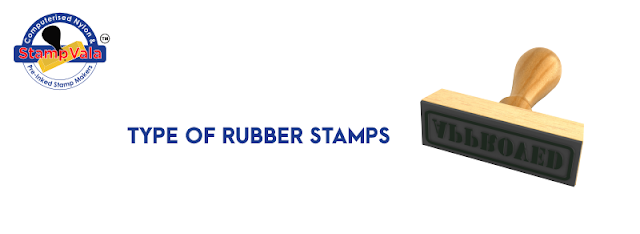Types of Rubber Stamp
An image or pattern that has been carved, moulded, laser etched, or vulcanized onto a sheet of rubber is known as a rubber stamp. In the craft of rubber stamping, commonly known as stamping, a dye or pigment-based ink is applied to the rubber stamp. The rubber is frequently fastened to a more sturdy item, such a block of wood, a brick, or an acrylic. An acrylic handle can be utilised to hold the vulcanised rubber image, which is increasingly affixed to a cling vinyl sheet with an adhesive foam backing. These cling rubber stamps are often less expensive than their wood mounted counterparts and take up less room in storage.
It might be challenging to determine what distinguishes the
many high-quality rubber stamps we provide and which variation is most suitable
for your needs. Here is some information to assist you pick the best rubber stamp for your needs about the three most popular varieties of rubber stamps: traditional,
pre-inked, and self-inking:
1. Pre-Inked Stamp
Dislike the separate ink pad? Pre-inked rubber stamps
eliminate the need for it because the oil-based ink is already moulded into the
stamp. Simply apply pressure to the stamp, and the ink will flow through the
die plate to produce a clear, perfect image. The best part is that pre-inked
stamps often last for 50,000 or more impressions, so you won't frequently need
to stop stamping to re-ink them.
2. Self-Inking rubber stamp
Self-inking rubber stamps don't need an additional ink pad,
much like their pre-inked counterparts. This is due to the fact that each time
you push down on a stamp, it gets automatically inked. Self-inking rubber
stamps also have the advantage of never bleeding through paper because they
employ water-based ink. They require re-inking after around 7,000 impressions,
which is significantly sooner than pre-inked rubber stamps, although adding
extra ink is simple. Self-inking stamps are also a fantastic option for people
looking for quick and easy stamping
3. Traditional rubber stamp
This is what most people picture when they think of a rubber
stamp. Traditional rubber hand stamps are a little archaic since you have to
use a different ink pad each time you wish to make an impression, as opposed to
self-inking and pre-inked stamps. Although this can seem cumbersome, it's often
a beneficial thing because it enables you to utilise several ink colours with
the same stamp. Therefore, the traditional rubber hand stamp is probably your
best option if you want to use your stamp for crafts or another activity that
calls for a range of ink colours. This will prevent you from having to purchase
a stamp for each ink colour you intend to use.
Wrapping up
Business-related rubber stamps frequently have an address,
company logo, and business registration number. Additionally, some stamps
contain moveable components that let the user change the stamp's inscription or
date. They are used to indicate special processing for papers as well as to
date incoming mail. In certain nations, it is customary to rubber-stamp official
documents like contracts over the signature as extra authentication. The goal
is to verify the contracts, prevent forgery, and boost productivity by doing
away with the requirement that corporate officials sign each document
individually.



Comments
Post a Comment